family
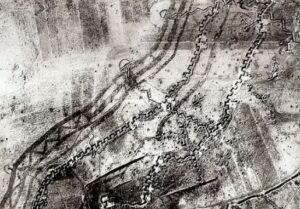
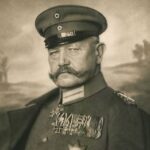 As World War I…the “War to end all Wars,” was coming to a close, there still remained one serious German stronghold that had to be taken down in order to ensure Allied success in winning the war. That stronghold, known to the Allies as the Hindenburg Line, an area they named after the German commander in chief, Paul von Hindenburg, was built in late 1916. The Germans called it the Siegfried Line. Either was, the Hindenburg Line was a heavily fortified zone running several miles behind the active front between the north coast of France and Verdun, near the border of France and Belgium. This area was a must win, must take back line, if the Allies were going to win the war.
As World War I…the “War to end all Wars,” was coming to a close, there still remained one serious German stronghold that had to be taken down in order to ensure Allied success in winning the war. That stronghold, known to the Allies as the Hindenburg Line, an area they named after the German commander in chief, Paul von Hindenburg, was built in late 1916. The Germans called it the Siegfried Line. Either was, the Hindenburg Line was a heavily fortified zone running several miles behind the active front between the north coast of France and Verdun, near the border of France and Belgium. This area was a must win, must take back line, if the Allies were going to win the war.
The German army was working hard to make it very difficult to break through the Hindenburg line by September 1918. At that time, the German line consisted of six defensive lines. The zone formed by these six lines measured some 6,000 yards deep, and it was ribbed with lengths of barbed wire and dotted with concrete emplacements to be used as firing positions. It was a fortress that the Germans were sure would be impenetrable. However, while the Hindenburg Line was heavily fortified, it was not without weakness. Its southern part was most vulnerable to attack, because it included the Saint Quentin Canal, and the entire area was not totally out of sight of artillery observation by the enemy. Any attack by the Allies would need to come through this weakness. Another weakness was that the whole system was laid out linearly, as opposed to newer constructions that had adapted to more recent developments in firepower and were built with scattered “strong points” laid out like a checkerboard to enhance the intensity of artillery fire. These things would be the saving grace for the Allies, and the downfall for the Germans.
Knowing these vulnerabilities, the Allies began to concentrate all the force built up during their so-called “Hundred Days Offensive,” to their advantage. The operation kicked off on August 8, 1918, and by late September, the Allies had gained a decisive victory at Amiens, France, against the Hindenburg Line. Australian, British, French, and American forces participated in the attack on the Hindenburg Line. The attack began with a huge bombardment, using 1,637 guns along a 10,000-yard-long front. The final 24 hours of the offensive saw the British firing a record 945,052 shells. After capturing the Saint Quentin Canal with a creeping barrage of fire…126 shells for each 500 yards of German trench over an eight-hour period, the Allies successfully breached the Hindenburg Line on September 29, 1918.
The attack was pushed forward by Australian and United States troops, who, out of a must-win sense of urgency, attacked the heavily fortified town of Bellicourt with tanks and aircraft. The battle raged on for four days, with heavy losses on both sides. Finally, the Germans were forced to retreat. With Kaiser Wilhelm II 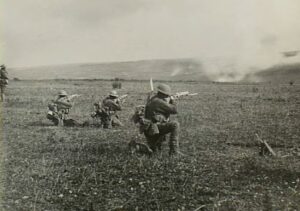
 pressured by the military into accepting governmental reform and Germany’s ally, Bulgaria, suing for an armistice by the end of September, the Central Powers were in disarray on the battlefield, as well as the home front. The Allies continued to press their advantage on the Western Front throughout the month of October, and against their predictions, World War I came to an almost abrupt end on November 11, 1918.
pressured by the military into accepting governmental reform and Germany’s ally, Bulgaria, suing for an armistice by the end of September, the Central Powers were in disarray on the battlefield, as well as the home front. The Allies continued to press their advantage on the Western Front throughout the month of October, and against their predictions, World War I came to an almost abrupt end on November 11, 1918.
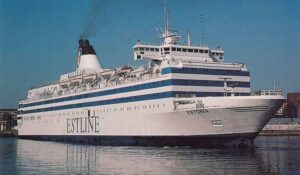
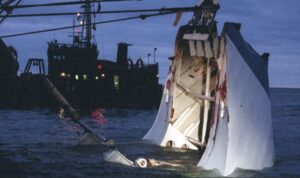 I love to ride on the Ferry boats in Washington state. It’s especially cool to have your car right there with you at the end of your journey. You just get in and go off to the rest of your adventure. Of course, a Ferry boat is just that…a boat, and that always leaves the possibility of one sinking. That has happened on numerous occasions. It seems to me though that most of the time when they sink, it is in open waters, and not the inland waters, such as the Puget Sound.
I love to ride on the Ferry boats in Washington state. It’s especially cool to have your car right there with you at the end of your journey. You just get in and go off to the rest of your adventure. Of course, a Ferry boat is just that…a boat, and that always leaves the possibility of one sinking. That has happened on numerous occasions. It seems to me though that most of the time when they sink, it is in open waters, and not the inland waters, such as the Puget Sound.
One such maritime disaster in open waters, occurred on September 28, 1994, when a large car-and-passenger ferry…MS Estonia, sank in the Baltic Sea, killing 852 people. MS Estonia was a cruiseferry built in 1980 at the West German shipyard Meyer Werft in Papenburg. The ship was sold to Nordström and Thulin in 1993, for use on Estline’s Tallinn–Stockholm route. Estonia departed slightly behind schedule that night, departing at at 7:15pm on September 27. It was expected in Stockholm the next morning at about 9:00am. The ship was carrying 989 people, which included 803 passengers and 186 crew. The seas were rough that night, and it was determined by a 1997 investigation, that the ship’s bow door locks had failed during the storm. However, new underwater footage appears to show a previously unrecorded 13-foot hole in the ship’s hull. Given that information, many people think that it might have been a Russian torpedo that took down the MS Estonia. Whatever the case may be, the sinking of Estonia was one of the worst maritime disasters of the 20th century.
The main reason for the new theory is that Estonia was traveling on an overnight cruise from Tallinn, the capital city of Estonia, to Stockholm, Sweden, when it sank off the coast of Finland. Estonia is a former Soviet republic that gained its independence in 1991, but the last Russian troops actually left in 1994. Tallinn was a popular and affordable travel destination for Swedes. The Estonia was a type of ferry known as a “ro-ro,” which featured a smorgasbord, live music, dancing and drinking, and allowed people to drive vehicles onto one end of the ship and drive off on the other end.
There is no doubt that the stormy weather played a part in the disaster, because in the storm, the waves reached an estimated 15 to 20 feet. The Estonia went down in the middle of the night. It went down so quickly, that many passengers were trapped inside the ship. Some were able to escape and managed to make it into lifeboats. Some of those later drowned in the frigid water or died from hypothermia. Out of the 989 souls on board Estonia, only 137 survived, most of those were rescued by helicopters.
Officially, a joint Swedish-Finnish-Estonian government committee ruled it an accident and blamed it on stormy 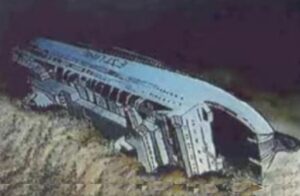
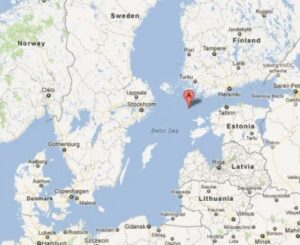 weather that caused water to pour through an open bow door and into the Estonia’s car deck, destabilizing the ship and capsizing it in less than an hour. Nevertheless, there were others, including some family and friends of the Estonia victims, who believed the sinking was the result of a pre-existing hole caused by a collision or explosion. I don’t suppose that the full truth will ever be known, but the loss of life will forever be felt.
weather that caused water to pour through an open bow door and into the Estonia’s car deck, destabilizing the ship and capsizing it in less than an hour. Nevertheless, there were others, including some family and friends of the Estonia victims, who believed the sinking was the result of a pre-existing hole caused by a collision or explosion. I don’t suppose that the full truth will ever be known, but the loss of life will forever be felt.

 Athena Salazar is my grandson, Josh Petersen’s fiancée, and they are planning for the soon arrival of their little baby boy. Athena and Josh met in middle school, and while they weren’t an item then, they became an item when they reconnected at work almost two years ago, they quickly knew that it was love. I have been so amazed at how perfect they are for each other. Each of them is the perfect complement to the other. Athena is such a gentle person, and at this stage in her life, she is very ready to be a mommy…very ready!! And Josh is growing and becoming the man of the house.
Athena Salazar is my grandson, Josh Petersen’s fiancée, and they are planning for the soon arrival of their little baby boy. Athena and Josh met in middle school, and while they weren’t an item then, they became an item when they reconnected at work almost two years ago, they quickly knew that it was love. I have been so amazed at how perfect they are for each other. Each of them is the perfect complement to the other. Athena is such a gentle person, and at this stage in her life, she is very ready to be a mommy…very ready!! And Josh is growing and becoming the man of the house.
Athena loves children. She has nieces and nephews who are very dear to her. She even works in a daycare center, which doesn’t surprise me, because it is very much the essence of Athena. She has a heart for people, but especially for children. I think she is going to be a wonderful mother. Athena also has a wonderful sense of 
 humor. She can be totally goofy one minute and very sentimental the next. That is really just what Josh needed in his life. Someone to laugh with, as well as live out all the romantic, sentimental dreams that they both have.
humor. She can be totally goofy one minute and very sentimental the next. That is really just what Josh needed in his life. Someone to laugh with, as well as live out all the romantic, sentimental dreams that they both have.
Athena is a mix of sunflowers and red roses…her favorite flowers. I like that. She is a little bit country sunshine and a little bit quiet romance. Her home is decorated largely in sunflowers, with red roses mixed in, which makes it feel bright and sunny. I remember when Josh lived alone, and his walls were almost empty. His place needed a woman’s touch, and that’s where Athena came in. Now their house is a home, and soon their baby boy will come and make them a family…and what a wonderful day that will be. They can’t wait to get their family started!!

 I love the couple that these two kids are. I can say kids, because I’m the grandma, and they will always be the kids to me. Grandmas can get away with that. I love how in love these kids are, and I can’t wait to see where their future takes them. Their pregnancy pictures are so cute, and I love how Josh is doing the “sympathy pregnancy” act, so Athena doesn’t feel alone. I’m not even sure he realizes it. He just loves her so much that it comes naturally. Today is Athena’s birthday. Happy birthday Athena!! Have a great day!! We love you!!
I love the couple that these two kids are. I can say kids, because I’m the grandma, and they will always be the kids to me. Grandmas can get away with that. I love how in love these kids are, and I can’t wait to see where their future takes them. Their pregnancy pictures are so cute, and I love how Josh is doing the “sympathy pregnancy” act, so Athena doesn’t feel alone. I’m not even sure he realizes it. He just loves her so much that it comes naturally. Today is Athena’s birthday. Happy birthday Athena!! Have a great day!! We love you!!

 Through the years, there have been a few men who made a conscious decision not to engage in an act of war. One such officer was submarine officer Vasili Arkhipov, who avoided nuclear war during the Cuban Missile Crisis in 1962. He wasn’t alone in seeing the insanity of launching a nuclear weapon, however. Another Soviet officer, Lieutenant Colonel Stanislav Petrov, made the same decision not to launch an attack that could have triggered a nuclear exchange on September 26, 1983. These two men basically disobeyed an order to launch their respective nuclear attacks, to their credit.
Through the years, there have been a few men who made a conscious decision not to engage in an act of war. One such officer was submarine officer Vasili Arkhipov, who avoided nuclear war during the Cuban Missile Crisis in 1962. He wasn’t alone in seeing the insanity of launching a nuclear weapon, however. Another Soviet officer, Lieutenant Colonel Stanislav Petrov, made the same decision not to launch an attack that could have triggered a nuclear exchange on September 26, 1983. These two men basically disobeyed an order to launch their respective nuclear attacks, to their credit.
Petrov was part of the Soviet Air Defense Forces, stationed at the Serpukhov-15 bunker near Moscow. September 26, 1983, started out as a typical Monday, but it would end as anything but a typical day. That day, just three weeks after the Soviet military had shot down Korean Air Lines Flight 007, Petrov was the duty officer at the command center for the Oko nuclear early-warning system. Suddenly, the system reported that a missile had been launched from the United States, followed by up to five more. For anyone who has seen the movie, “War Game” it would seem like a video game gone rouge. Apparently, it seemed much like that for Petrov too, because he judged the reports to be a false alarm.
While Petrov saw that this attack could not be, his superiors could not see that, and they ordered the counterattack. Petrov made the decision to disobey orders, against Soviet military protocol, and this could have meant grave consequences for him. This was Russia, after all. Nevertheless, Petrov is credited with having prevented an erroneous retaliatory nuclear attack on the United States and its NATO allies that could have resulted in a large-scale nuclear war. That war could have wiped out half of the population of the countries involved. Petrov had to truly believe that what he saw with his eyes, was not reality. Every second counted…attack or stand down!! Petrov chose to stand down!! An investigation later confirmed that the Soviet satellite warning system had indeed malfunctioned. There was no attack coming from the United States. The decision Petrov made, not to launch a retaliatory nuclear strike amid this incident, caused Petrov to be credited as having “saved the world” and by refusing to launch an attack, potentially saving millions, if not billions of lives.
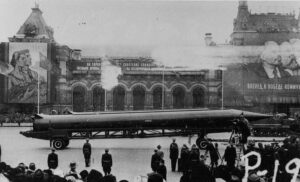
 I don’t recommend that orders always be disobeyed or taken lightly, but I think it is vital for soldiers, officers, and even civilians, to consider the consequences on both sides, and maybe…just maybe, disasters can sometimes be avoided. Launching nuclear missiles, is truly a last-ditch act. It cannot be reversed, and if these missiles are launched, people will die. And in the case of Petrov, it would have all been for nothing.
I don’t recommend that orders always be disobeyed or taken lightly, but I think it is vital for soldiers, officers, and even civilians, to consider the consequences on both sides, and maybe…just maybe, disasters can sometimes be avoided. Launching nuclear missiles, is truly a last-ditch act. It cannot be reversed, and if these missiles are launched, people will die. And in the case of Petrov, it would have all been for nothing.

 Jolene Thompson is my niece, Kellie Hadlock’s boyfriend, Tim Thompson’s daughter, and she is such a little sweetheart. She always has a smile on her face, and she is totally fearless. She is a totally tough little girl. She is an amazing big sister to her siblings, and helps take care of them, but this summer, she got to spend with her dad, and they had the best summer. Jolene is in 1st grade this year, and she spent the summer learning to ride her bike and learning how to swim. She excelled at both new skills and can’t get enough of them. Her dad is a great teacher, and he guided his little girl to the level of expert in no time. She
Jolene Thompson is my niece, Kellie Hadlock’s boyfriend, Tim Thompson’s daughter, and she is such a little sweetheart. She always has a smile on her face, and she is totally fearless. She is a totally tough little girl. She is an amazing big sister to her siblings, and helps take care of them, but this summer, she got to spend with her dad, and they had the best summer. Jolene is in 1st grade this year, and she spent the summer learning to ride her bike and learning how to swim. She excelled at both new skills and can’t get enough of them. Her dad is a great teacher, and he guided his little girl to the level of expert in no time. She 
 even jumped off of the high dive in Thermopolis without hesitation…multiple times!! She is totally fearless in all aspects of her life.
even jumped off of the high dive in Thermopolis without hesitation…multiple times!! She is totally fearless in all aspects of her life.
Jolene loves to draw and color. She has that creative gene, I think. She also loves to brush and style Kellie’s hair, which if you know my family at all, is like the greatest blessing ever. Some people hate to have their hair touched, but our family…can’t get enough of having our hair brushed, styles, or just touched. Some people might call that weird, but if you like having your hair brushed and such…well, you just know what I mean. With Kellie, Jolene gets to do all the girly things that she doesn’t get to do normally, because at home, either with her dad or her mom, there is no doing the girly things. Not everyone likes the dress-up, fix the hair, girly things. That is a blessing for both Jolene and Kellie. They are best friends, and they love each other very much.
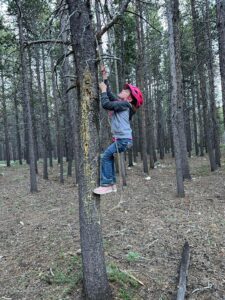

During her summer with her dad, Jolene got to do a lot of camping, hiking, and shooting. She also got to go fishing, and of course bicycling and swimming. She had a totally blissful summer. Her and her dad had a great summer…and they did all the things!! They went to a rock-climbing wall place, and Jolene climbed like an expert there too. She also showed off her climbing skills on the trees in the campgrounds she and her dad stayed in. Jolene got her first bow this year too and learned archery. Tim is a total outdoorsman, and Jolene wants to do everything her dad does, so she is eager to learn and to reach expert level. Today is Jolene’s 7th birthday. Happy birthday Jolene!! Have a great day!! We love you!!
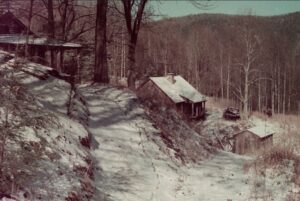
 As America grew, towns popped up in many places, only to dwindle into ghost towns when the expected industry that motivated their beginning, fell through. Lost Cove was one such town. Established just before the Civil War, it was once a thriving agricultural community, but then in the early 20th century, logging replaced farming, and the railroad brought workers. Somehow in the shuffle of changes, Lost Cove found itself off the beaten path, almost hidden in the forest, with no electricity or running water. The little town had to figure out something new, and so, because of the remoteness and because the town lay on the North Carolina/Tennessee border, an equally thriving moonshine industry was born.
As America grew, towns popped up in many places, only to dwindle into ghost towns when the expected industry that motivated their beginning, fell through. Lost Cove was one such town. Established just before the Civil War, it was once a thriving agricultural community, but then in the early 20th century, logging replaced farming, and the railroad brought workers. Somehow in the shuffle of changes, Lost Cove found itself off the beaten path, almost hidden in the forest, with no electricity or running water. The little town had to figure out something new, and so, because of the remoteness and because the town lay on the North Carolina/Tennessee border, an equally thriving moonshine industry was born.


Many people might think that the moonshine industry was all due to prohibition, and that is largely true, but while bootlegging was a crime of opportunity, it was also quite likely to be a crime of necessity. Still, while moonshine could provide a living for the residents, it would never be able to sustain a whole ton for very long. Eventually, the residents of Lost Cove began to move away to laces where they could make a living. The town, now empty, seen fell into disrepair. These days Lost Cove is a graveyard of abandoned homes and crumbling gravestones. Because Lost Cove was on the border, either state could have agreed on jurisdiction to collect tax revenues, but both declined to, thereby creating a haven for bootlegging.
Even with the logging business doing well, the timber eventually thinned and the railroad service that brought passenger trains through the area stopped. With that, the Lost Cove residents became even more isolated. The nearest stores were eight miles away, and they would have to walk for basic supplies, mostly because they didn’t have money for any other form of transportation. Soon the infrastructure deteriorated too, and the rough 
 or non-existent roads led to even more shortages. In the end, here was nothing left, but to leave. The last known resident left in 1957. Sadly, in 2007, a fire destroyed most of what still stood in Lost Cove. All that is left now is a few structures, memories, and the history of the area, only seen by the occasional hiker, using trails that remain the only route of access.
or non-existent roads led to even more shortages. In the end, here was nothing left, but to leave. The last known resident left in 1957. Sadly, in 2007, a fire destroyed most of what still stood in Lost Cove. All that is left now is a few structures, memories, and the history of the area, only seen by the occasional hiker, using trails that remain the only route of access.
 Man has always been interested in the stars and planets, even before we really knew what they were. Those mysterious lights in the sky that somehow just showed up every night and disappeared every morning, only to be replaced with the bright sunlight, quickly became a part of our lives from the time we were born. The main thing that has changed over the centuries is the equipment with which we could view space for ourselves.
Man has always been interested in the stars and planets, even before we really knew what they were. Those mysterious lights in the sky that somehow just showed up every night and disappeared every morning, only to be replaced with the bright sunlight, quickly became a part of our lives from the time we were born. The main thing that has changed over the centuries is the equipment with which we could view space for ourselves.
On September 23, 1846, Johann Gottfried Galle, a German astronomer from Radis, Germany, at the Berlin Observatory with the assistance of student Heinrich Louis d’Arrest, was the first person to view the planet Neptune and know what he was looking at. Of course, other astronomers had seen other planets, but this was the first time anyone actually saw the eighth planet in our solar system. Neptune was believed to be out there in that position, as French astronomer Urbain-Jean-Joseph Le Verrier had calculated the approximate location of the planet to be. Le Verrier, by studying gravity-induced disturbances in the  motions of Uranus guessed that another planet was there. He then told Galle of his findings on the 23rd, and the same night Galle and his assistant Heinrich Louis d’Arrest identified Neptune at their observatory in Berlin. Basically, they looked at its movement against a background of stars over 24 hours and that confirmed that it had to be a planet…seeing a place where the stars were blocked by “something” or in this case, Neptune.
motions of Uranus guessed that another planet was there. He then told Galle of his findings on the 23rd, and the same night Galle and his assistant Heinrich Louis d’Arrest identified Neptune at their observatory in Berlin. Basically, they looked at its movement against a background of stars over 24 hours and that confirmed that it had to be a planet…seeing a place where the stars were blocked by “something” or in this case, Neptune.
Neptune is a blue gas giant, which has a diameter four times that of Earth. The astronomers named it after the Roman god of the sea…why do they always use the Greek or in this case Roman gods? Neptune has eight known moons, of which Triton is the largest. It also has a ring system containing three bright and two dim rings. It completes an orbit of the sun once every 165 years. Since Pluto was “deplanetized” in 2006, because it was demoted to dwarf planet, Neptune became the farthest known solar planet. While it may be the furthest out, it  is not the smallest, but rather it’s the fourth-largest planet by diameter, the third-most-massive planet, and the densest giant planet. Neptune’s mass is 17 times the mass of Earth, and slightly more massive than its near-twin Uranus. Neptune is more dense and physically smaller than Uranus, because its greater mass causes more gravitational compression of its atmosphere. It is referred to as one of the solar system’s two ice giant planets
is not the smallest, but rather it’s the fourth-largest planet by diameter, the third-most-massive planet, and the densest giant planet. Neptune’s mass is 17 times the mass of Earth, and slightly more massive than its near-twin Uranus. Neptune is more dense and physically smaller than Uranus, because its greater mass causes more gravitational compression of its atmosphere. It is referred to as one of the solar system’s two ice giant planets
In 1989, the US spacecraft Voyager 2 was the first human spacecraft to actually visit Neptune. Nevertheless, while much more has been learned about the eighth planet, the first person to actually find it was Johann Gottfried Galle, way back in 1846.

 I don’t think any of us could have foreseen the changes that would occur in ten short years of marriage. Jason Sawdon became my nephew when he married my niece Jessica Hadlock on August 18, 2012, in what they have dubbed “the most amazing, fun party celebrating love.” They have been celebrating ever since that day. When they got married, Jason was a patrolman for the Wyoming Highway Patrol. He still works for the Wyoming Highway Patrol, but in a different capacity these days. A little over a year ago, Jason was promoted to Sergeant of Equipment and Technology, in a change that unfortunately for the rest of the family, took his family from Casper to Cheyenne. So, in the next step in his decorated career, they moved to Cheyenne on June 5, 2021. It was hard for all of us to have them go, but it was the best thing for their family. Jason is no longer on the street, and his hours are much better for a family man. His girls need him home at night.
I don’t think any of us could have foreseen the changes that would occur in ten short years of marriage. Jason Sawdon became my nephew when he married my niece Jessica Hadlock on August 18, 2012, in what they have dubbed “the most amazing, fun party celebrating love.” They have been celebrating ever since that day. When they got married, Jason was a patrolman for the Wyoming Highway Patrol. He still works for the Wyoming Highway Patrol, but in a different capacity these days. A little over a year ago, Jason was promoted to Sergeant of Equipment and Technology, in a change that unfortunately for the rest of the family, took his family from Casper to Cheyenne. So, in the next step in his decorated career, they moved to Cheyenne on June 5, 2021. It was hard for all of us to have them go, but it was the best thing for their family. Jason is no longer on the street, and his hours are much better for a family man. His girls need him home at night.

They have spent the last year exploring their new city, and enjoying their new house, which Jason spent a lot of time refreshing for them before they moved in. This past year brough some sadness, in that they lost Daisy, their sweet Boxer dog, but now they have adopted a new Boxer dog that they named Riley. She has been so great for their family, and she is Jason and Jessi’s daughter, Adelaide’s best friend…and for Jason and Jessi, that means everything. As far as they are concerned, their little daughter, Adelaide is the best thing that has ever happened to them, and we all agree. She has been such a blessing.
Jason is such a happy person. He has a great sense of humor and loves to tease, but Jason also has a heart of gold. I will never forget what he did for my mom after my dad had passed away. Her birthday was on January 1st, so we always had a party for her. She and my dad always had their special dance. With Dad gone, mom 
 felt like “the forgotten dancer” until Jason took her out on the dance floor. She struggled to stand on her own, but he held her up, and she got her dance. That was the single most amazingly precious thing I have ever seen…and I will never forget his kindness to her. It meant the world to her. That is the essence of the kind of person Jason is…with everything and everyone. Anyone who has ever been on the receiving end of Jason’s kindness, knows just what I mean. Today is Jason’s birthday. Happy birthday Jason!! Have a great day!! We love you!!
felt like “the forgotten dancer” until Jason took her out on the dance floor. She struggled to stand on her own, but he held her up, and she got her dance. That was the single most amazingly precious thing I have ever seen…and I will never forget his kindness to her. It meant the world to her. That is the essence of the kind of person Jason is…with everything and everyone. Anyone who has ever been on the receiving end of Jason’s kindness, knows just what I mean. Today is Jason’s birthday. Happy birthday Jason!! Have a great day!! We love you!!

 The year 2002 proved to be a really bad one for Hawkins and Powers Aviation of Greybull, Wyoming. Hawkins and Powers had a contract with the United States Forest Service (USFS), to drop fire retardant on wildfires across the country. That year, two large airtankers…a Lockheed C-130 Hercules and a Consolidated PB4Y-2 Privateer…crashed about a month apart while performing aerial firefighting operations. No one saw this coming, but the crashes resulted in a review of the maintenance and use of the entire US large airtanker fleet. Once the review started, they found enough problems that it ultimately brought about the grounding of the whole fleet, which was comprised of 33 aircraft in all. The grounding dramatically reduced the resources available to fight major wildfires. These planes were a vital part of the arsenal used by the forest service to contain wildfires without loss of life and structures. Nevertheless, the planes had to be safe.
The year 2002 proved to be a really bad one for Hawkins and Powers Aviation of Greybull, Wyoming. Hawkins and Powers had a contract with the United States Forest Service (USFS), to drop fire retardant on wildfires across the country. That year, two large airtankers…a Lockheed C-130 Hercules and a Consolidated PB4Y-2 Privateer…crashed about a month apart while performing aerial firefighting operations. No one saw this coming, but the crashes resulted in a review of the maintenance and use of the entire US large airtanker fleet. Once the review started, they found enough problems that it ultimately brought about the grounding of the whole fleet, which was comprised of 33 aircraft in all. The grounding dramatically reduced the resources available to fight major wildfires. These planes were a vital part of the arsenal used by the forest service to contain wildfires without loss of life and structures. Nevertheless, the planes had to be safe.
The review was prompted by the wings of these planes actually folding up and coming off mid-flight, bringing the aircraft down instantly. One of the crashes was actually caught on camera when a tourist was filming the firefighting efforts and happened to be filming at exactly the moment the wings came off. I can only imagine the shock they must have felt when they saw that. I have only seen pictures, knowing full well what is about to happen, and it still gets to me. The thought they were filming an amazing firefighting event, only to find themselves filming a tragedy.
The first accident involved a Lockheed C-130 Hercules, on June 17, 2002, near Walker, California. The plane, registration N130HP, call sign Tanker 130, was flying against the Cannon Fire, which was located south of Lake 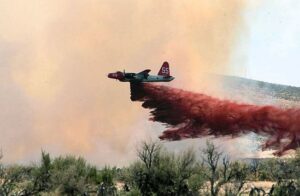 Tahoe and north of Yosemite National Park. The Cannon Fire crossed the California State Line and burned northward into the Walker River area in Nevada. More than 1000 people were evacuated from homes and camps in the mountains near Walker River, and at least one home was destroyed. The fire nearly tripled in size that Monday, growing from 5,000 acres to just under 15,000. The C-130 Hercules that went down fighting the fire killed 3 people that day. The aircraft, “previously United States Air Force (USAF) Serial Number 56-0538, was one of the original C-130A production series and had been built and delivered to the USAF in 1957. It was retired from military service in 1986. In May 1988, the aircraft was acquired from the General Services Administration by the USFS, which in August that year sold it and five other C-130s it had acquired to Hemet Valley Flying Service, for conversion to an airtanker. Hemet then sold the C-130 to Hawkins and Powers. At the time of the crash, the aircraft had logged 21,863 flight hours.”
Tahoe and north of Yosemite National Park. The Cannon Fire crossed the California State Line and burned northward into the Walker River area in Nevada. More than 1000 people were evacuated from homes and camps in the mountains near Walker River, and at least one home was destroyed. The fire nearly tripled in size that Monday, growing from 5,000 acres to just under 15,000. The C-130 Hercules that went down fighting the fire killed 3 people that day. The aircraft, “previously United States Air Force (USAF) Serial Number 56-0538, was one of the original C-130A production series and had been built and delivered to the USAF in 1957. It was retired from military service in 1986. In May 1988, the aircraft was acquired from the General Services Administration by the USFS, which in August that year sold it and five other C-130s it had acquired to Hemet Valley Flying Service, for conversion to an airtanker. Hemet then sold the C-130 to Hawkins and Powers. At the time of the crash, the aircraft had logged 21,863 flight hours.”
The second crash, also caused by structural failure, occurred on July 18, 2002, near Estes Park, Colorado. The structure failure in this case was in the wing’s spar adjacent to the left side of the fuselage. Tanker 123, by callsign, was loaded with 2,000 US gallons of fire retardant at the time of the accident. The plane had begun a left turn to line up for its eighth drop of the day on the Big Elk Fire, and while it was still in the 15–20° left bank, the witnesses on the ground and in another tanker saw the left wing separate from the aircraft and “fold upwards”, followed almost immediately by the initiation of a fire. Without its left wing, the aircraft continued to roll left, and crashed to the ground at a 45° nose down attitude. The impact started a large fire at the wreck site. Both crewmen were killed instantly.
The aircraft, “a Consolidated PB4Y-2 Privateer registered N7620C, was built during World War II. It had been delivered in July 1945 to the United States Navy, which used it for coastal patrol duties. In 1952, it was 
 transferred to the United States Coast Guard, which operated it until it was retired in 1956. The aircraft was removed from storage and converted to an airtanker in 1958, then was flown by several different companies, the last being Hawkins and Powers. At the time of the crash, the airframe had logged 8,346.3 flight hours.” The Big Elk Fire burned approximately 4,348 acres.
transferred to the United States Coast Guard, which operated it until it was retired in 1956. The aircraft was removed from storage and converted to an airtanker in 1958, then was flown by several different companies, the last being Hawkins and Powers. At the time of the crash, the airframe had logged 8,346.3 flight hours.” The Big Elk Fire burned approximately 4,348 acres.

 My grandniece, Hattie Parmely is just growing up so fast. She and her sister Reagan are homeschooled on their farm by their mom, Ashley Parmely, while their younger brother attends pre-school in town for one more year, and their younger sister, Maeve is in her first year of pre-school in town. Once the two younger kids are done with pre-school, they will be homeschooled too. Hattie and Reagan got to go to Denver with their grandpa, Albert Eighmy recently, to visit their grandma, Kari Eighmy, who was taking some training for work in Denver for a couple of weeks. The girls had a great time.
My grandniece, Hattie Parmely is just growing up so fast. She and her sister Reagan are homeschooled on their farm by their mom, Ashley Parmely, while their younger brother attends pre-school in town for one more year, and their younger sister, Maeve is in her first year of pre-school in town. Once the two younger kids are done with pre-school, they will be homeschooled too. Hattie and Reagan got to go to Denver with their grandpa, Albert Eighmy recently, to visit their grandma, Kari Eighmy, who was taking some training for work in Denver for a couple of weeks. The girls had a great time.
It’s hard to believe that Hattie is eight years old already. She really seems more mature than that though. I think that is common with farm kids, because part of their everyday life involves the responsibilities of the farm animals, and their care. A lot of kids have chores to do, but the chores of farm kids are very different than the chores of city kids. Hattie and her siblings have witnessed many animal births, and of course some deaths too. They know firsthand what life’s all about. They have mucked stalls, bottle fed the babies, and carried feed to the animals. Of course, there is the fun stuff too. Hattie and her 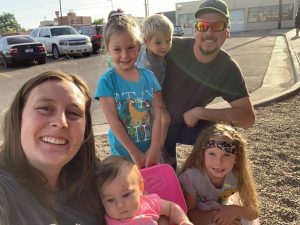 asiblings regularly get to ride their horses, play with the baby goats and kittens, jump on their trampoline, ride round on the tractor with their dad, Eric Parmely. Like most kids these days, Hattie’s driving skills began early when she got her own little car, which is too small for her now, of course. She also likes to float the river with her family, and she is getting really good at maneuvering a kayak.
asiblings regularly get to ride their horses, play with the baby goats and kittens, jump on their trampoline, ride round on the tractor with their dad, Eric Parmely. Like most kids these days, Hattie’s driving skills began early when she got her own little car, which is too small for her now, of course. She also likes to float the river with her family, and she is getting really good at maneuvering a kayak.
Hattie and her older sister, Reagan both have their own dog. They are responsible for their own dog’s care. Hattie named her dog Lucy, while Reagan named hers Bristol. The younger children will get a dog of their own when they turn seven. That is the age their parents decided that they were old enough to handle the care of their own dog. Maeve doesn’t care too much that she can’t have a dog yet, especially since they also have several family dogs, but Bowen can’t wait, and isn’t sure he thinks it’s fair that he has to.
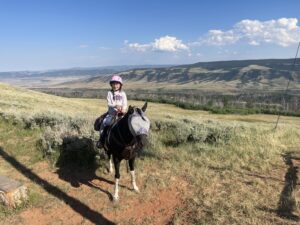
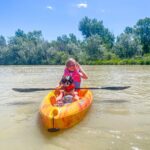
Hattie is growing into such a little lady. She has her own style, and it’s perfect for her. She kind of a girly girl, but she can rough and tumble with the best of them. She is a good big sister to Bowen and Maeve, but they do occasionally get on her nerves, as does her sister, Reagan. It’s just the way of having siblings, and anyone who has siblings knows that is true. That’s just how it is. Today is Hattie’s 8th birthday. Happy birthday Hattie!! Have a great day!! We love you!!

